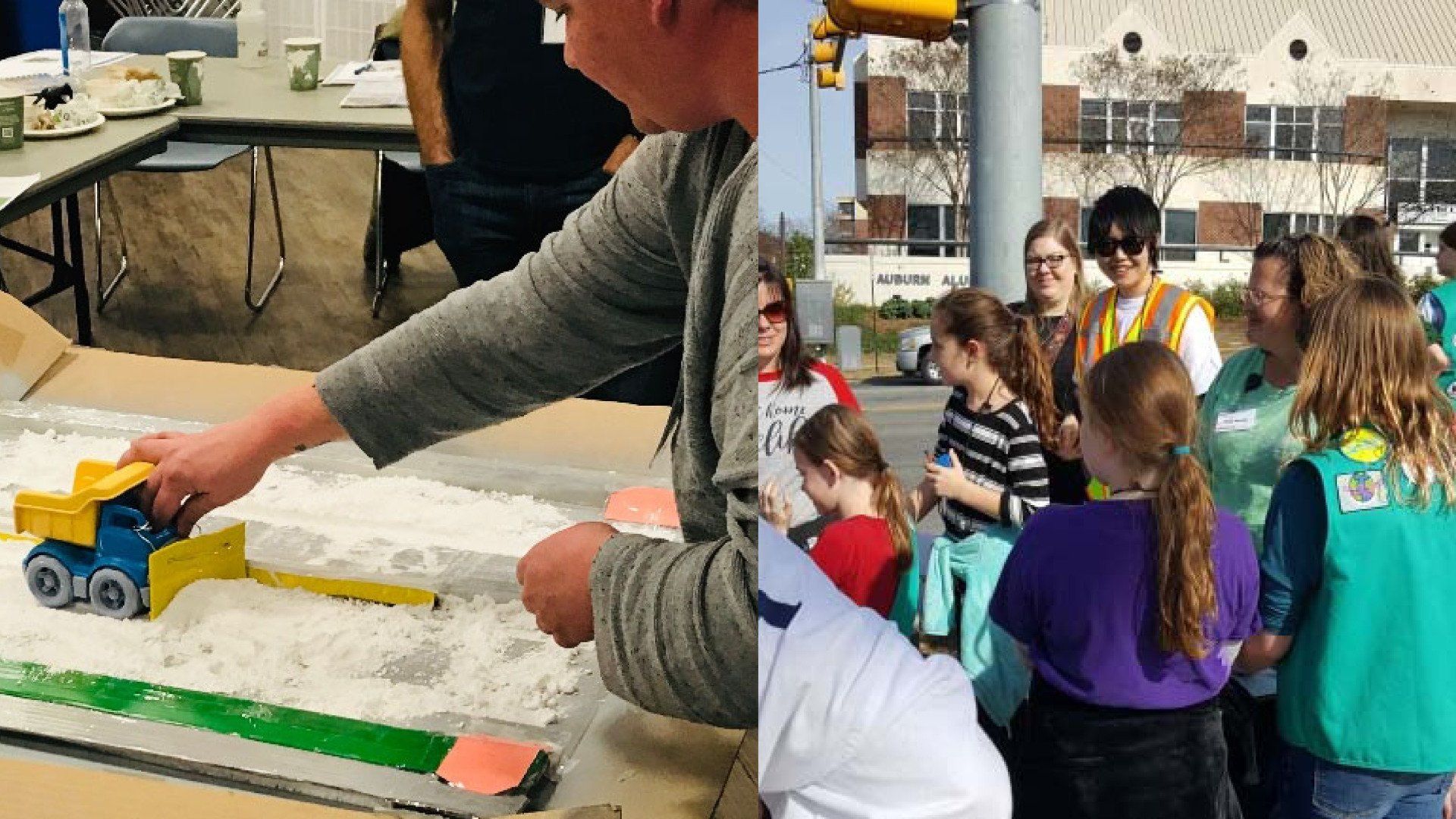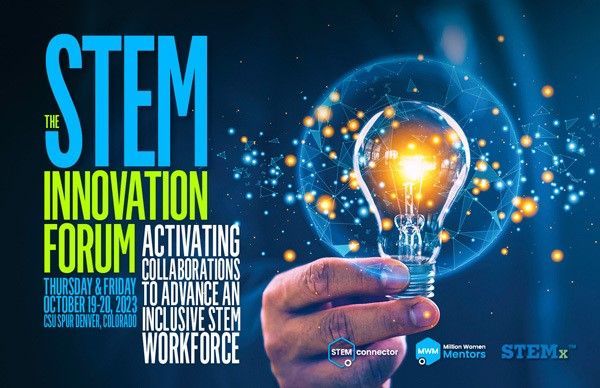News
News and Member Insights

By Rob Evans
•
01 Nov, 2023
by Heather Sherman, Director of STEMx The 2023 STEM Innovation Forum: Activating Collaborations to Advance an Inclusive STEM Workforce was a success! Through our collaboration with STEMconnector and Million Women Mentors, we convened 160 leaders from industry, government, non-profit organizations, and education institutions from all over the United States to discuss strategies and best practices to support the STEM workforce. We were honored to host a variety of dynamic speakers including: Jared Polis, Governor of Colorado Brynt Parmeter, Chief Talent Management Officer, U.S. Department of Defense Dr. Athina Kanioura, Executive Vice President, Chief Strategy and Transformation Officer, PepsiCo and Dr. Lisa Hinkelman, Founder and CEO of Ruling Our eXperiences (RoX). We extend our gratitude to our panelists, Learning Session speakers, and participants who joined us in Denver. Broadening participation We set out share information on trends in STEM education and workforce development, with an emphasis on broadening participation in STEM careers. Resources from sessions highlighting strategies for broadening participation are linked below: DoD STEM: Developing a STEM Workforce to Support the National Security Mission Priming the Pump for High Demand STEM Careers STEM Workforce Readiness for Teen Girls: “If She Can See It, She Can Be It” Driving change Another goal of the forum was to feature high impact strategies, programs and solutions that are driving change, and STEMx members from LASTEM , the PAST Foundation and MBRT showed how they are engaging youth and building career awareness through their workforce programs. Emerging technologies We looked towards the future to better understand how emerging technologies will change the world and the ways we must prepare STEM talent for jobs in logistics, artificial intelligence, research safety , bioenergy , and renewable technologies. Chevron‘s sponsored panel, “Cultivating the Talent to Drive the Innovation and Technologies for Ever-Cleaner Energy” was a rich discussion featuring experts from Chevron, Project Lead the Way and the National Renewable Energy Laboratory. Dr. Jamie Vernon, Executive Director, and CEO, Sigma Xi Society was a fantastic moderator for this discussion. Next steps We have linked event resources including videos, slide decks and collateral on the event landing page . The event photo gallery is located there as well. If you attended, please complete our 30 second event survey . Five lucky winners will be selected at random to receive a Forum water bottle! More importantly, your feedback matters to us. If you did not attend, mark your calendar for next fall - we’re looking to make next year even bigger! If you are interested in hosting in your state, or have thoughts about compelling content that we should include, please reach out to Heather Sherman .

By Rob Evans
•
10 Mar, 2023
A new series of listening sessions from the White House will lay the groundwork for the next Federal STEM Strategic Plan and we need your input! Together, the members of STEMx advance high quality STEM education as a workforce and equity imperative. The White House Office of Science and Technology Policy (OSTP) is taking feedback on the upcoming Federal STEM Strategic Plan. Using the form below, share some of your ideas and the STEMx Policy Advisory Team will share this feedback with OSTP. OSTP will host a series of virtual listening sessions to inform the development of the next Federal STEM Strategic Plan. Six sessions will be held between March 15 – 24. From OSTP, the aim of these sessions is to gather “information and perspectives on the challenges faced by – and within – the STEM ecosystem in the United States and solutions that might be implemented by the U.S. Government” from a variety of stakeholders. Members of the STEMx Policy Advisory Team will attend the listening sessions on behalf of STEMx. They will represent the identified STEMx policy priorities, along with STEMx member feedback on the topics identified by OSTP. These topics are the themes for the listening sessions, and will likely show up in the final STEM Strategic Plan: STEM Education: Support learners and educators in and across all science and technology disciplines STEM Workforce Development: Prepare and recruit our Nation’s future STEM workforce STEM Workforce: Foster inclusive STEM learning and working spaces to retain STEM learners and workers STEM Engagement: Foster meaningful community and public engagement in science and technology STEM Research and Innovation Capacity: Build and drive capacity and cutting-edge STEM (and STEM education) research and development The National STEM Ecosystem This is the moment to help OSTP create a Federal STEM Strategic Plan that reflects the reality we live in, work in, and experience each day. This is the moment to show the power of the STEMx network – to use our collective voice to shape the direction of the plan, to help define the language used, and highlight proven strategies that can make a difference for all STEM learners. We are collecting STEMx member feedback here . Over the next week, add feedback, thoughts, statistics related to that topic. The Policy Advisory Group members will share this feedback on behalf of STEMx during the Listening Sessions. The listening sessions are open to the public. Visit the OSTP website for a complete list of sessions, times and registration links.

By Rob Evans
•
26 Jan, 2023
Policy Briefing & Advocacy Day March 21-22, 2023 STEMx is hosting a Congressional advocacy event exclusively for our members in Washington, DC on March 21-22, 2023! Join fellow STEM leaders on Capitol Hill to meet with federally elected officials and key policymakers. Advocate together for high-quality STEM education opportunities as a workforce and equity imperative. The CHIPS and Science Act of 2022 authorized new and expanded investments in STEM education and training from K-12 to community college, undergraduate and graduate education. The act's passage offers a powerful chance to renew the focus on STEM education and the 21 st century workforce. As leaders of STEM networks, we need to use the power of our collective voice to help our policymakers prioritize investments and legislation that fully support STEM education and workforce development. Benefits of attending STEMx on the Hill: Represent your STEM network as part of a national movement to advocate for STEM education. Meet your state’s Congressional Delegation, and advocate for your state’s STEM priorities. Network with other STEMx members to share policy ideas and best practices. Participate in panel discussions with key policymakers. Who should attend STEMx on the Hill? All STEMx members are invited and encouraged to attend. You are welcome to bring other members of your organization, particularly those who are engaged in policy and advocacy. Since STEMx no longer has access fees, each attendee is responsible for lodging and travel costs.

By Rob Evans
•
06 Dec, 2022
A widely cited differentiator and value-add for members is the focus and expertise at STEMx on education policy advocacy, particularly at the federal level. We’re launching three new opportunities to help STEMx educate leaders about legislative policy advocacy and leverage the expertise within the network to advance high quality STEM as a workforce and equity imperative, in each state and nationally. Each of us is called to be an advocate for high-quality STEM education within the bounds of our current organizational roles. Whether you are permitted to lobby or not, all of us can (and should) educate our elected officials about issues we are facing as we work to promote access to STEM. To support and engage your efforts in education policy advocacy, we’re announcing: Plans for a STEM Policy Forum in March 2023 Formation of a STEMx Policy Advisory Group First cohort of the STEMx Policy Institute

By Rob Evans
•
27 Oct, 2022
On October 12th, U.S. Deputy Secretary of Education Cindy Marten announced the YOU Belong in STEM initiative at the Innovating for the Future Summit, held by STEMx in partnership with STEMConnector and Million Women Mentors. This initiative aims to improve STEM education outcomes by advancing a sense of inclusion and belonging in STEM for all students and teachers and has three primary goals:

By Rob Evans
•
22 Aug, 2022
The bipartisan 2022 CHIPS and Science Act has some exciting provisions for K-12 students in rural communities—thanks in part to the work of Battelle. Battelle manages a range of programs advancing STEM education, including the STEMx network. Battelle, on behalf of STEM educators nationwide wide, advocated for key elements of the bill to key leaders in Congress. Idaho Idaho STEM Action Center: STEM education, including the STEMx network. Battelle, on behalf of STEM educators nationwide wide, advocated for key elements of the bill to key leaders in Congress. LINK Idaho National Laboratory: STEM education, including the STEMx network. Battelle, on behalf of STEM educators nationwide wide, advocated for key elements of the bill to key leaders in Congress. LINK The new law includes a rural STEM education pilot program modeled after the Tennessee Rural STEM Collaborative (TRSC), developed by the Battelle-managed Tennessee STEM Innovation Network (TSIN). The Rural STEM Collaborative Pilot included in the bill authorizes the National Science Foundation (NSF) to establish “regional cohorts in rural areas that will provide peer support, mentoring, and hands-on research experiences for rural STEM educators, principals, and other school leaders of students in prekindergarten through grade 12, in order to build an ecosystem of cooperation among educators, principals, other school leaders, researchers, academia, and local industry.” Thomas Phillips, Senior Congressional Affairs Specialist on the Government Relations & Public Policy team in Washington D.C., says the initiative has been a long time coming. “We started discussions with the House Science Committee over three years ago, during the last Congress, when they were developing a draft bill to promote rural STEM education,” he explained. At that time, committee staff reached out to learn more about the STEM education initiatives at the Department of Energy (DOE) national labs that Battelle manages, many of which tend to be in rural communities. Ultimately, however, the committee decided to move the focus to new programs at NSF, rather than DOE, in order to better align with a similar measure being considered in the House. While initially disappointed, Phillips saw an opportunity to introduce the committee staff to the Tennessee and Ohio STEM initiatives that Battelle manages Through those conversations, committee staff learned about the model of the Tennessee Rural STEM Collaborative. They were impressed. An initial bill with language modeled on TRSC passed quickly, with strong bipartisan support in the House, but was ultimately stalled in the Senate in the last Congress. Fortunately, the bill (and the Battelle-developed pilot program) was re-introduced in this Congress and quickly passed both chambers. After a year in legislative limbo, the bills were finally conferenced together in the CHIPS and Science Act, which was signed into law by President Biden on Aug. 9. Through it all, Battelle has been working both behind the scenes and with many coalitions and partners to influence the direction and language of the new law. The success of TSIN and OSLN caught the attention of lawmakers early on. The NSF pilot program written into the CHIPS and Science Act is directly modeled after the TRSC. The Battelle Government Relations and Education teams also had the opportunity to provide input into the rest of the bill. “We leveraged the expertise of not just the OSLN and TSIN but all our STEMx membership and crafted cohesive policy recommendations based on the real-world experiences of our network leaders and educators in their communities,” said Phillips. Battelle also helped to shape language defining STEM ecosystems as networks, which has a direct impact on what kinds of organizations will be eligible for the newly authorized NSF funds. We hope to see the Rural STEM Collaborative pilot adopted by more state and regional STEM networks as a result of the new legislation. More work remains to be done; while the bill authorizes funding for NSF to establish additional regional rural STEM networks, funds have not yet been appropriated by Congress. “I plan to stay engaged as NSF moves into the implementation stage. This is a great opportunity for the Education team to scale up and expand our impact with help from NSF,” said Phillips . “Seeing this through to implementation will demonstrate to the House Science Committee their instinct to come to us as experts was right. It will help us work with them to shape the policy of tomorrow.” STEMx will host conversations with members about the CHIPS and Science Act in the coming months, to strategize how we can effectively use these funds to advance high-quality STEM education nationally.

By Rob Evans
•
18 Jul, 2022
Q: Why and how should transportation matter to students involved in STEM education? A: Transportation is part of our lives every day, whether in how we travel or in how things we need get to us. Because we are all so involved in transportation, it is easy to take it for granted and not recognize its importance or what it takes to ensure our systems work well. There are so many diverse applications of STEM in transportation. We need bright minds bringing diverse perspectives to solve the transportation challenges of now and the future – from creating sustainable and environmentally friendly vehicles and systems to integration of robotics and autonomous driving to design innovations that enable people with physical or other limitations to safely get to where they need to go. No matter what your STEM interest, you can find a way to have a successful career in transportation. Q: Tell us about the transportation resources developed by the Institute of Transportation Engineers: What is the ITE, and why did it create these resources? What do they consist of, and what level of students are they for? A: ITE – A Community of Transportation Professionals is an international membership association of transportation professionals who work to improve mobility and safety for all transportation system users and help build smart and livable communities. The organization includes a diverse range of transportation professionals who work to improve transportation systems and our communities in a variety of ways. ITE recognizes the importance of building a pipeline of STEM professionals for the transportation workforce, which is why the ITE STEM Committee was created. The STEM resources are intended to help students learn about transportation topics and careers and to provide support for teachers or ITE members who want to lead transportation learning activities for K-12 students. There are resources available for preK-high school students ( https://www.ite.org/stem ), including hands-on activities, research projects and career videos (plus more). Q: How can teachers use these resources in the classroom? Can students use the resources on their own? A: Each of the STEM lessons available on the site provides information about the grade level most likely to benefit from the activity, background information needed to successfully lead the activity, expected duration and material requirements. These lessons can be integrated into STEM classes or even math and science courses where topics covered are relevant. For example, the Ramps and Friction activity can be introduced during science lessons when friction is being discussed to provide a hands-on learning experience. Students can also use the resources on their own to explore career options, such as by watching the videos of professionals talking about their careers or exploring the career resource links provided on the site. Q: Can these materials be used to foster student interest in transportation careers? A: Absolutely! Our committee’s goal with these resources is to make it easier for teachers and ITE members to share information about transportation careers. The activities and resources are designed to engage students in fun learning opportunities that help them understand the roles, impact and importance of transportation professionals. Q: What do you see as the future of transportation? What kind of transportation careers might we see and how will they be different from today’s jobs? How can educators best prepare students for these careers? A: The future of transportation is exciting – so much is changing as technology evolves. Transportation professionals of the future will be responsible for a complete transformation of our transportation systems as we move toward autonomous and connected vehicles and infrastructure. They will be involved in the move toward zero emissions to reduce the impact of transportation on our environment. They will also be at the forefront of designing systems so that our communities are livable and inclusive, providing accessibility to safe and efficient transportation for everyone. All of these challenges require workers with stronger technical backgrounds and more interdisciplinary skills than ever before. There are opportunities for students through any educational pathway, from technical certifications to advanced university degrees. Educators can help prepare students by exposing them to transportation topics and challenges, providing experiential learning opportunities where students can create, innovate and problem-solve, and engaging transportation professionals to bring real-world experience into the classroom. Q: Is there anything else you would like to share about current and future STEM education in general? A: As what is needed in the workplace continues to evolve, so must STEM education. The best path forward, in my opinion, is through partnerships between K-12, higher education and industry. By working together, we can create unique learning experiences that empower students to find their fit in terms of both educational and career pathways and better prepare them for the workforce of the future.

By Rob Evans
•
20 Apr, 2022
Q: You are working with STEMx on a training series on pre-apprenticeship programs for schools. What is a pre-apprenticeship program? A: The U.S. Department of Labor defines pre-apprenticeship as a program or set of strategies designed to prepare individuals for entry into Registered Apprenticeship Programs (RAP) or other job opportunities. Youth pre-apprenticeships combine academic and technical classroom instruction with work experience that is directly linked with a RAP. Youth pre-apprenticeships may start any time during high school, but work-based learning experiences for youth may not begin before the youth turns 16. Pre-apprenticeship programs have varied program elements; however, at the core, they place an individual on a pathway to employability through a RAP. Traditionally, apprenticeships and pre-apprenticeships have been in construction and trades. However, in the past several years, the Labor Department has been working closely with multiple industries to expand RAPs and registered pre-apprenticeship programs. Currently, apprenticeship spans more than 1,000 occupations including careers in health care, cybersecurity, information technology and energy. Apprenticeship training is distinguished from other types of workplace training by several factors, including paid work experience, classroom instruction, mentorship and a portable, nationally recognized credential. Youth who complete a registered pre-apprenticeship receive a pre-apprenticeship certificate of completion that can be used as a demonstration of their competency. Completion of a pre-apprenticeship does not require a person to enter a RAP, nor does it guarantee a position in a RAP. But it does provide a young person with a “leg up” as they matriculate to work or other post-secondary education or training. Q: What characteristics make up a good pre-apprenticeship program? According to the Labor Department, a quality pre-apprenticeship program provides: Training and curriculum based on industry standards, approved by an apprenticeship sponsor. Strategies that increase apprenticeship opportunities for disadvantaged individuals. Access to support services that help participants remain in the program. Collaboration with program sponsors to promote apprenticeship to other employers. Hands-on experience that simulates work performed in an apprenticeship with proper supervision and safety protocols. Formal agreements with apprenticeship sponsors for entry into registered apprenticeships (when possible). As long as a registered pre-apprenticeship program complies with these requirements, it has tremendous flexibility in the depth and breadth of program experiences. This flexibility enables school and industry partners to create and personalize academic and work-based learning experiences to meet their region, industry and school needs. Q: Are certain groups of students targeted for such a program? A: While many Ohio high schools are interested in pre-apprenticeship programs to help students meet Ohio’s new career readiness competency alternative for graduation, pre-apprenticeship programs can and should be made available to any interested student. Q: How do such programs differ from early college credit experiences? A: Pre-apprenticeship programs generally do not include or require a student to complete college credit. That said, some registered pre-apprenticeship programs may include college level coursework that is relevant to the career field. For example, if a two-year college or adult career center offers a college level course that prepares a student to successfully earn the Comp TIA IT Fundamentals + certification, then a student in an information technology focused pre-apprenticeship might be able to complete that certification and earn college credit or articulated college credit. Q: What impacts do pre-apprenticeship programs have on students and the workplace? A: Quality pre-apprenticeship programs are a starting point toward a successful career path for underrepresented job seekers (such as disadvantaged women and men, individuals with disabilities and others) who might not be aware of this approach to obtain good jobs with opportunities for advancement. Pre-apprenticeships help individuals meet the entry requirements for apprenticeship programs and ensure they are prepared to be successful in their apprenticeship. A wide variety of pre-apprenticeship programs serve a broad range of populations. Some programs focus on serving a specific target population, such as military veterans, while many pre-apprenticeship programs focus on youth. ( https://www.dol.gov/sites/dolgov/files/ETA/apprenticeship/pdfs/pre_apprenticeship_guideforwomen.pdf page 3) Q: What advice would you give a school administrator who wants to start a pre-apprenticeship program? A: Each state has an office that manages the state’s pre-apprenticeship program. Contact that office and schedule a meeting to learn more about the state’s specific requirements. Join EnvisionEdPlus for one of our upcoming training sessions. Visit the EnvisionEdPlus Eventbrite Page for registration information. STEMx Hosts: A National Look at Promising Pre-Apprenticeship Practices (live virtual; Wednesday, April 27, 3-4 p.m. EDT). Free. Pre-apprenticeships and apprenticeships can be an attractive pathway to well-paying careers in skilled trades as well as health care, information technology and many more industry fields. This session is a national BYOP (bring your own partner) event where together you will learn about successful practices and models for pre-apprenticeships used across the nation. EnvisionEdPlus: District Sponsored Pre-Apprenticeship Design Lab (live virtual; Wednesday, June 8, 9 a.m.-3 p.m. EDT). Free. Did you know, districts and education service centers can be apprenticeship sponsors? As part of their statewide outreach plan for a RemotEDx grant, EnvisionEdPlus and Battelle’s STEMx national network will showcase how five Ohio districts have become state approved apprenticeship sponsors and designed personalized and flexible pre-apprenticeship programs to address critical staffing needs in their organizations. Meet the practitioners, discover their stories and reflect on how their lessons learned. Begin to create your own district sponsored pre-apprenticeship to apprenticeship program in your community. EnvisionEdPlus: LaunchPad Summer Institute (Tuesday and Wednesday, Aug. 9-10, 8:30 a.m.-3:30 p.m. each day) In person at the Lodge at Geneva-on-the-Lake in Geneva, Ohio. Early Bird Registration of $750 per team of three to five ends May 31. (Regular registration fee is $900 per team.) Join EnvisionEdPlus for a two-day LaunchPad immersive learning experience that will prepare high school teams to launch high quality career-college pathways including pre-apprentice to apprenticeship programs. Learn from and collaborate with like-minded education leaders as you envision, brainstorm and begin planning strategies to expand opportunities for your high school students. Youth will begin to see relevance in their learning; be exposed to practical, real-world work-based learning; and even begin to define their futures. Day 1 will focus on partnerships, plans and models. Day 2 will focus on brainstorming how Ohio’s flexibility options, work-based learning and “doable” credentials can enhance pre-apprenticeship experiences. Teams will meet one-on-one and in small groups with practicing schools and experts who will inspire innovation. Teams will also have time to work on their local plans. Contact me at EnvisionEdPlus for more information or to learn how we can support your organization starting a youth pre-apprenticeship program.
Visit our STEAM Hub
Educators and parents can access our STEAM hub for weekly lessons and resources.
© 2024
All Rights Reserved | Battelle



